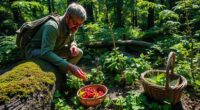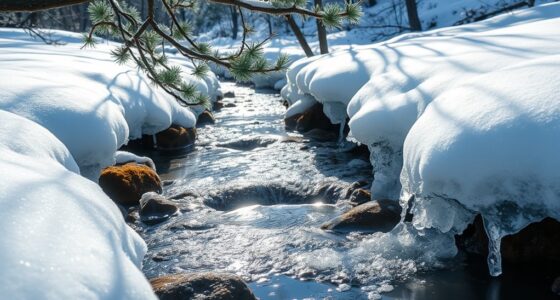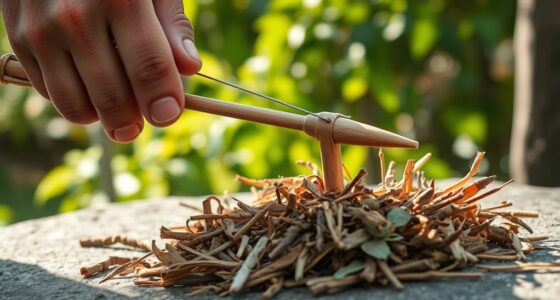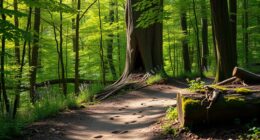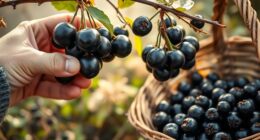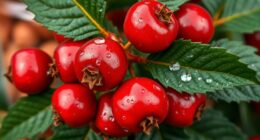Sustainable living through foraging lets you connect with nature while supporting local ecosystems and community traditions. By harvesting responsibly and respecting environmental guidelines, you can enjoy nutritious wild foods that boost your health and reduce reliance on store-bought products. Foraging promotes ecological awareness, preserves cultural knowledge, and minimizes environmental impact. You’ll discover how to blend traditional practices with modern sustainability, and continue exploring ways to nurture both your well-being and the planet.
Key Takeaways
- Promotes local, seasonal food sourcing that reduces transportation emissions and supports environmental conservation.
- Encourages sustainable harvesting practices to prevent resource depletion and protect ecosystems.
- Enhances community engagement and cultural heritage through shared knowledge and traditional foraging methods.
- Incorporates wild foods into diets, reducing reliance on store-bought, processed options and supporting plant-based nutrition.
- Fosters ecological awareness by understanding plant relationships, biodiversity, and the importance of habitat preservation.
Environmental Advantages of Foraging
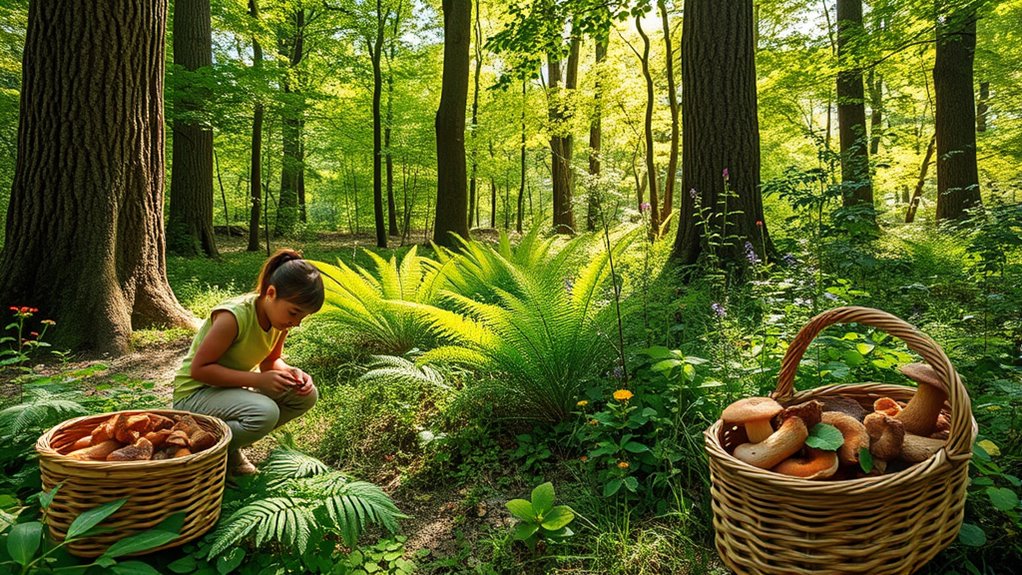
Foraging offers several significant environmental benefits that contribute to a more sustainable food system. By sourcing food locally, you cut down on transportation emissions, which lowers your carbon footprint. It also helps reduce food waste because you utilize often-overlooked, available wild foods. Engaging in responsible foraging can support native plant populations and promote resilient ecosystems. Choosing to forage encourages a plant-based diet, decreasing reliance on animal agriculture that drives deforestation. Your efforts support local biodiversity by conserving water resources and protecting habitats. This mindful approach fosters a culture of sustainability and resourcefulness, promoting conscious consumption. When you forage responsibly, you help maintain ecological balance and promote environmental awareness. Incorporating sustainable harvesting practices ensures that wild resources are not depleted and remain available for future generations. Practicing ethical foraging helps maintain the integrity of natural habitats and prevents overharvesting. Additionally, understanding foraging regulations is essential to ensure compliance and protect ecosystems. It’s a simple yet powerful way to reduce your environmental impact while connecting with nature and supporting sustainable practices.
Nutritional Benefits of Wild Foods
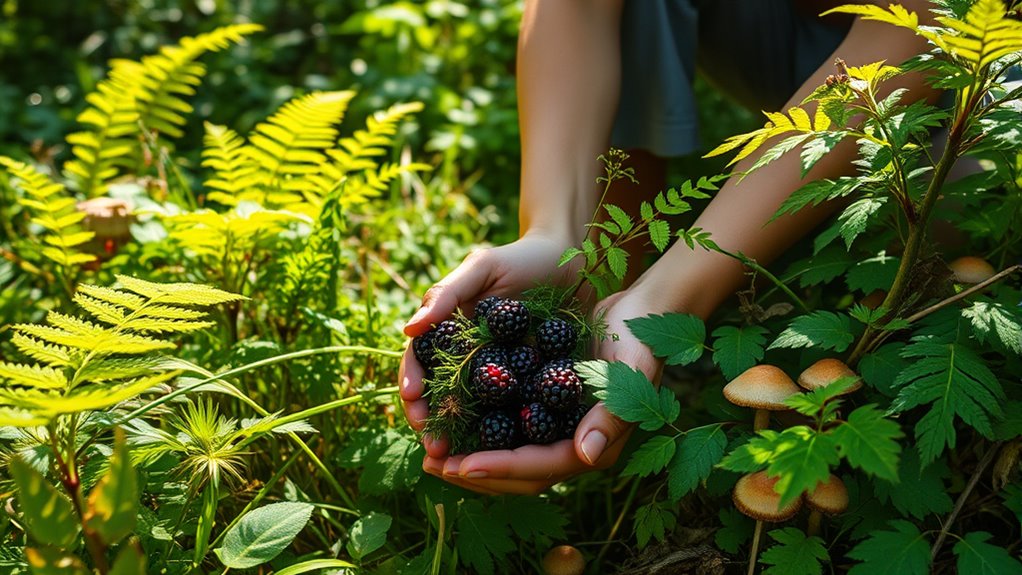
Wild foods not only support sustainable practices but also pack a powerful nutritional punch. They often contain higher levels of essential nutrients than farmed options, making them a nutrient-dense choice.
Many wild plants are rich in minerals like calcium, magnesium, zinc, potassium, and iron, which are crucial for your health. They also provide an abundance of vitamins A, B, C, and K, supporting immune function and energy production.
Wild berries and greens are especially high in antioxidants and phytochemicals that help protect your body from oxidative stress and reduce disease risk. These foods offer a diverse array of bioactive compounds, contributing to better overall nutrition.
Incorporating wild foods into your diet can boost your health while promoting sustainable, eco-friendly eating habits. Embracing diverse foods can lead to a more resilient and nutrient-rich diet. Additionally, understanding the nutritional benefits of wild foods encourages more mindful consumption and appreciation for natural, local sources of nutrition.
Consuming wild foods also supports local ecosystems by encouraging responsible harvesting practices that help maintain biodiversity and healthy environments. Recognizing the nutritional content of these foods can inspire more people to include them in their meals for enhanced health benefits.
Economic Impact and Community Support
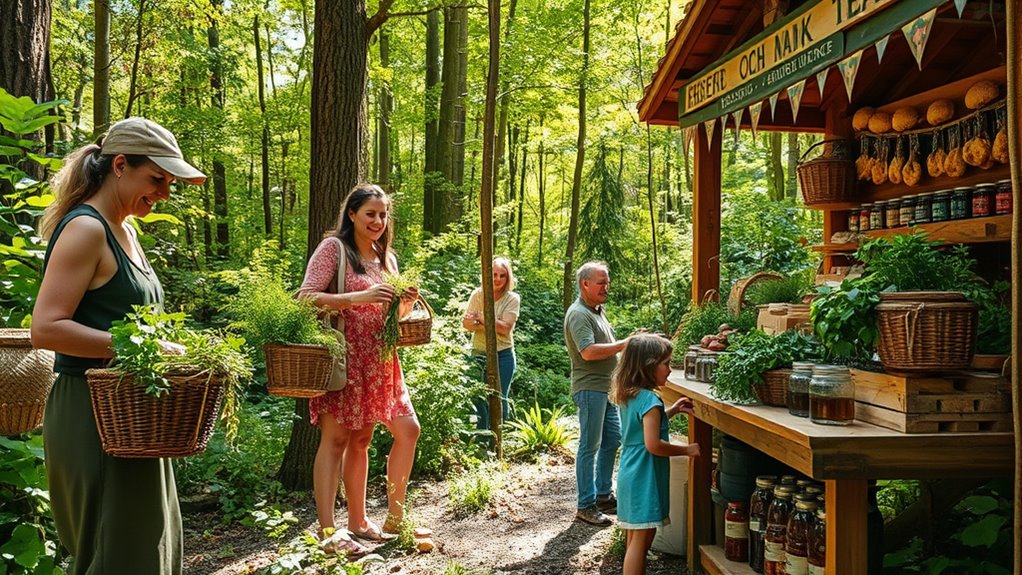
Engaging in foraging can substantially boost your household’s finances by providing access to free or low-cost food and resources. You can save money on groceries and energy costs by gathering wild plants, firewood, and plant fuels. Additionally, participating in community-led foraging initiatives can facilitate access to local foraging groups which often offer resources, workshops, and support to beginners and experienced foragers alike. These groups often promote sustainable harvesting practices that ensure the longevity of local ecosystems. Selling foraged products like tinctures, baskets, and mats can create additional income streams. Your involvement in foraging may also support local economies, especially through the sale of sustainable goods, fostering entrepreneurship. In urban areas, foraging promotes community interaction and intergenerational knowledge sharing, strengthening social cohesion. It acts as a cultural bridge, preserving traditional practices and local knowledge, which are vital for biodiversity conservation. Moreover, understanding the importance of native plant species can enhance sustainable foraging efforts and protect local biodiversity.
Promoting Mental and Physical Health
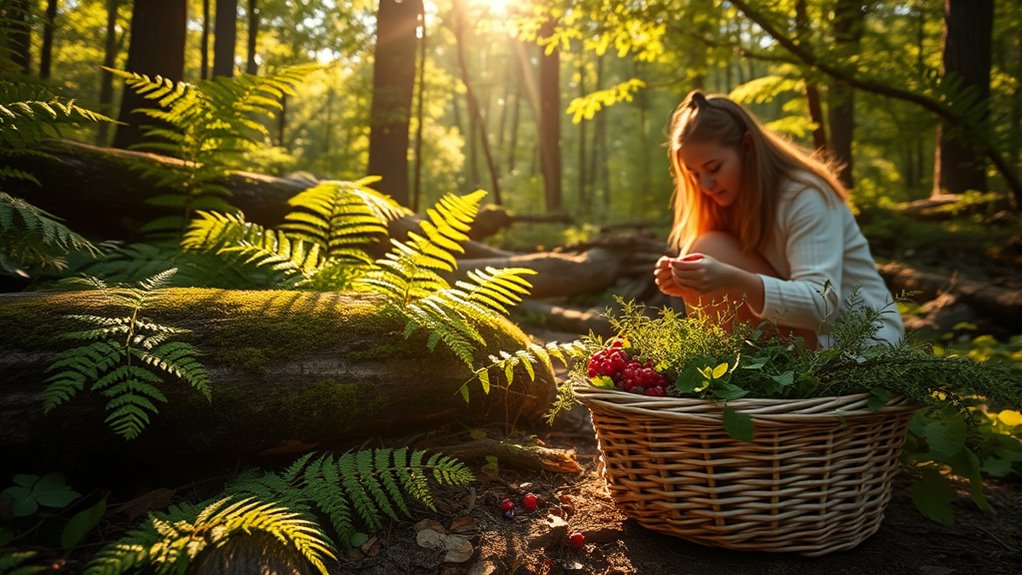
Spending time outdoors and actively searching for plants and resources can considerably boost your mental and physical well-being. Foraging engages your senses, helping reduce stress by fostering mindfulness and awareness of your surroundings. It distracts from daily worries, promoting relaxation and emotional balance. Incorporating comfort solutions such as appropriate footwear or supportive gear can make your foraging experience safer and more enjoyable. Physically, foraging involves walking and searching, which improves cardiovascular fitness, flexibility, and mobility. Consuming wild, nutrient-rich foods can also enhance your diet and boost vitamin D levels through outdoor exposure. Engaging in nutrient-rich foods during foraging can further support your overall health and immune function. The activity encourages exploration, discovery, and a sense of accomplishment, lifting your mood and strengthening emotional resilience. Additionally, learning to identify plants sharpens your focus and cognitive skills. Applying techniques for securing textiles during outdoor activities can also be beneficial in ensuring safety and efficiency in your search. Exploring the benefits of foraging can deepen your appreciation for nature and promote sustainable practices. Incorporating safety precautions such as proper gear and knowledge about local plant species ensures a safer foraging experience while protecting the environment.
Principles of Ethical Foraging
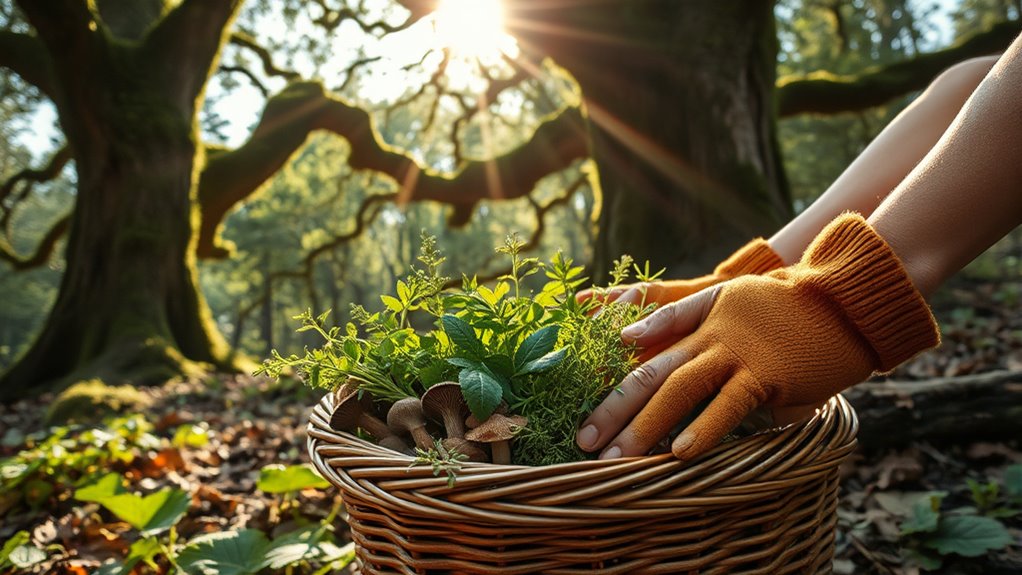
Have you ever wondered how to forage responsibly while respecting nature’s balance? Proper identification is vital—always positively identify plants before harvesting to avoid mistakes and harm. This helps ensure that you’re not unintentionally damaging native plant populations or disrupting local ecosystems. Practice mindful harvesting by taking only what you need, preventing resource depletion. Guarantee your harvesting doesn’t damage plant reproduction or ecosystems, following sustainable rates like the 5% rule. Respect local laws and avoid endangered or rare species. Think about the broader environment—choose areas with minimal human impact, monitor plant health, and avoid over-harvesting. Use appropriate tools and target perennial plants, which are more resilient. Following traffic signs and community guidelines can also promote responsible foraging. Additionally, be aware of local Water Parks and their seasonal activities to ensure your foraging trips do not interfere with local recreational areas. Incorporating sustainable practices can also help maintain healthy ecosystems for future foragers. Recognizing the importance of AI safety measures can further support responsible environmental stewardship and conservation efforts.
Cultural Heritage and Knowledge Preservation
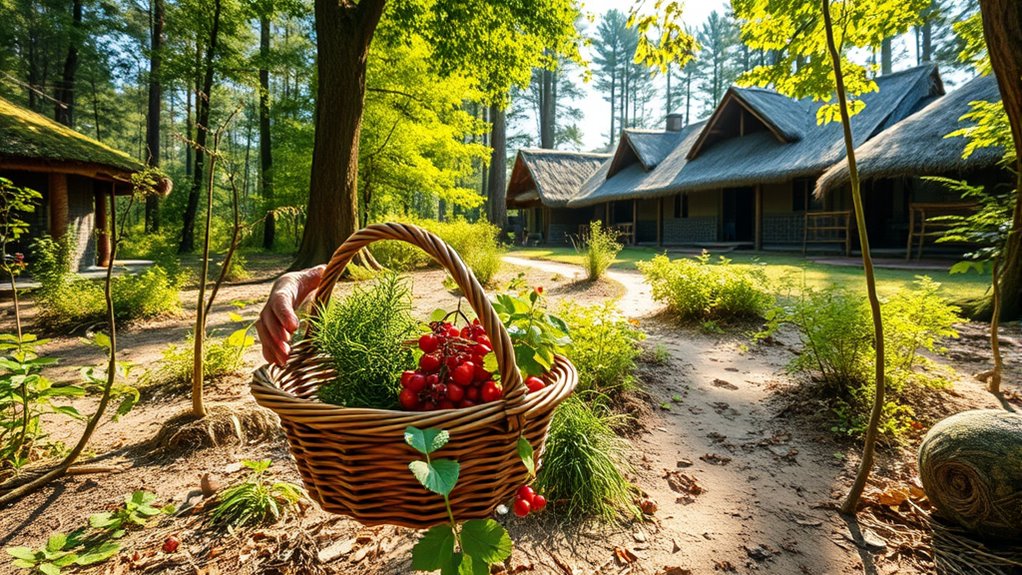
Responsible foraging isn’t just about respecting ecosystems; it also involves honoring the cultural traditions that have shaped this practice for generations. Foraging has been integral to human survival for thousands of years, with unique regional practices and local knowledge passed down through generations. These traditions influence local cuisines, giving each area distinctive flavors and nutritional benefits. Additionally, diverse designs of traditional tools and methods reflect the rich cultural heritage associated with this practice. Incorporating cultural intelligence helps us appreciate and adapt to these diverse practices respectfully and effectively. Recognizing the importance of Aboriginal history activities can deepen our understanding of Indigenous contributions to traditional foraging methods and cultural connection. Preserving this knowledge maintains cultural identity and fosters intergenerational bonds. Efforts like documentation projects, community involvement, and educational programs play crucial roles in safeguarding traditional practices amid environmental and societal changes. Supporting traditional ecological knowledge further emphasizes the value of Indigenous insights in sustainable foraging. Promoting intercultural exchange allows communities to learn from each other’s experiences and adapt traditional methods to modern contexts. Sharing and respecting foraging customs across cultures promotes appreciation for diverse heritages. Protecting this knowledge not only preserves cultural legacy but also supports biodiversity, sustains local economies, and encourages responsible, sustainable use of natural resources.
Practical Tips for Responsible Harvesting
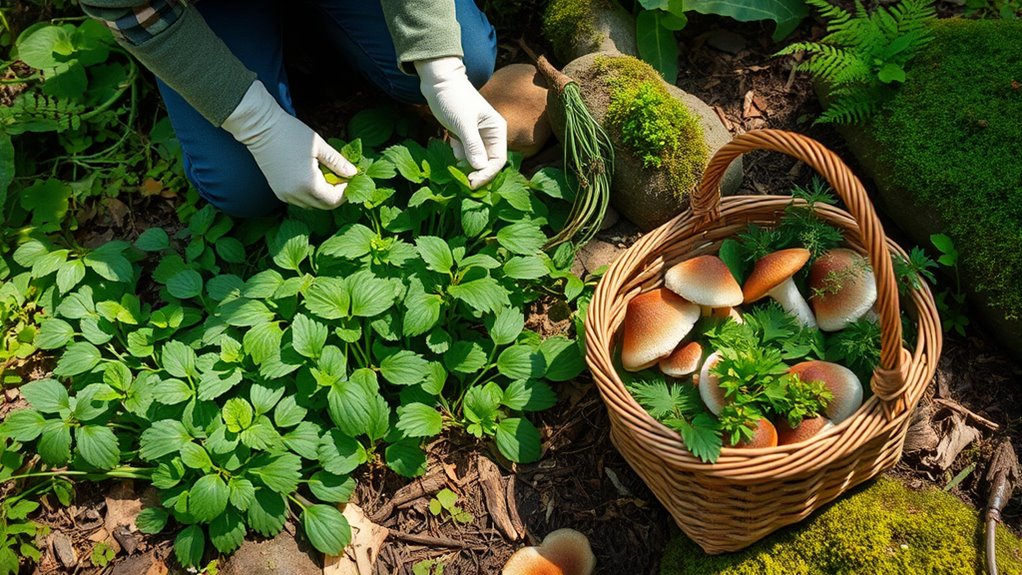
To harvest plants sustainably, it’s vital to understand and follow local laws and regulations, as they vary widely by region. Check whether foraging is allowed in your area and if permissions are needed for protected spaces. Ignorance of the law doesn’t excuse illegal activity, so thorough research is essential.
Always accurately identify plants before harvesting—consult multiple guides or experts to avoid dangerous lookalikes. Prioritize safety and only take what you need to prevent waste.
Consider the plant’s life cycle and harvest sustainably to allow regrowth. Respect habitats and avoid overharvesting in sensitive ecosystems.
Practice reciprocity by giving back—replant seeds or leave some resources for future use. Engaging with local communities and sharing knowledge further promotes responsible foraging habits.
How Foraging Fosters Ecological Awareness
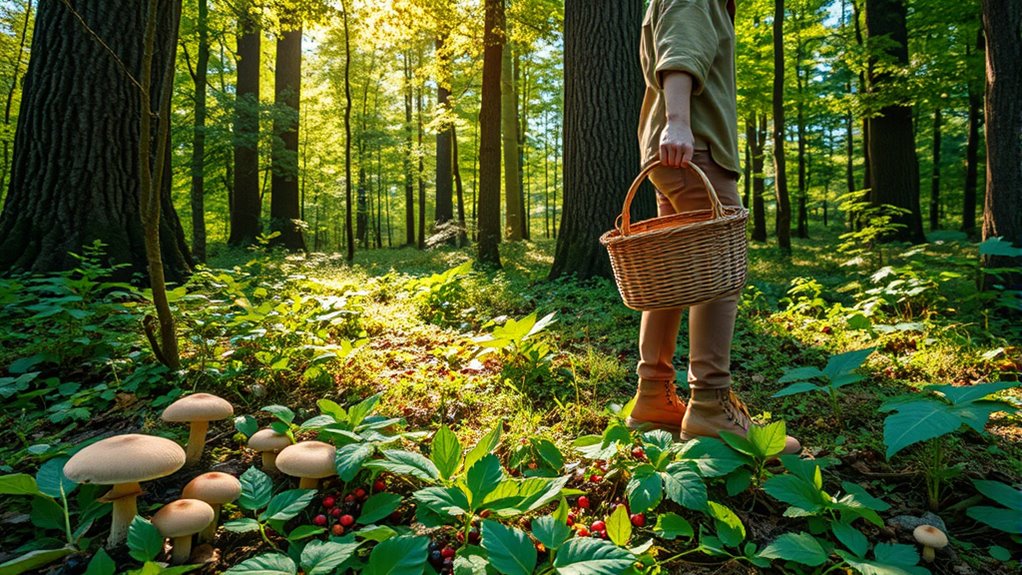
Foraging immerses you directly in the natural world, revealing the rich diversity of plants and animals that make up local ecosystems. As you explore, you recognize how different species depend on each other for survival, deepening your understanding of ecological relationships.
This hands-on experience fosters a sense of ecological dependence, showing how your actions impact the environment. Engaging with nature through foraging also enhances your appreciation and respect for the environment’s complexity, motivating you to protect it.
You learn crucial survival skills aligned with natural cycles, reinforcing the importance of sustainable practices. Additionally, foraging can revive cultural traditions and knowledge about traditional food sources, connecting you to centuries-old ecological wisdom.
All these aspects cultivate a heightened ecological awareness essential for sustainable living.
Incorporating Foraging Into a Sustainable Lifestyle
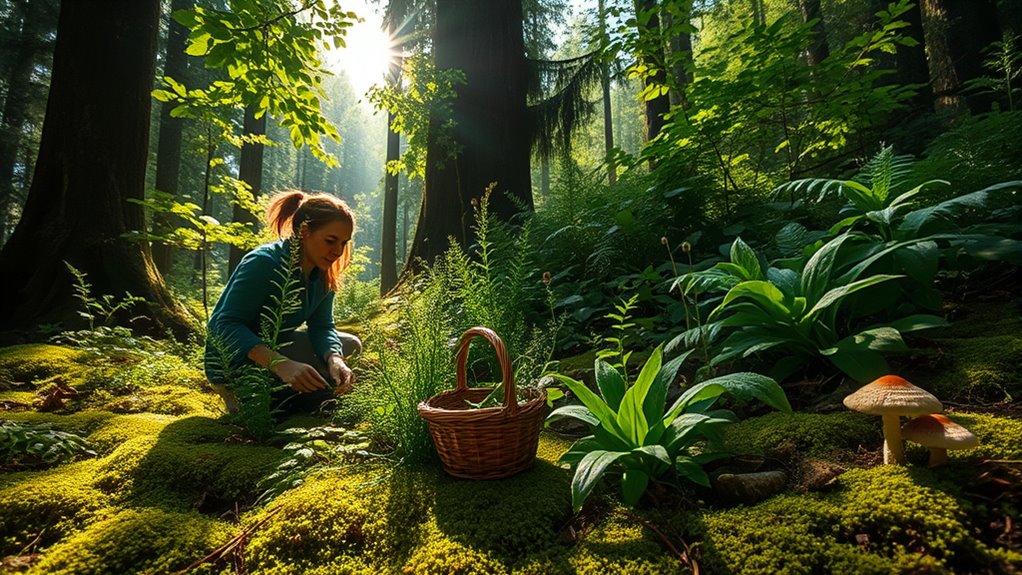
Incorporating foraging into your daily routine offers practical ways to support a more sustainable lifestyle. You can add wild ingredients to meals, boosting flavor and nutrition while reducing reliance on store-bought goods.
Foraging encourages physical activity, like walking and bending, promoting better health. It also fosters community bonds when shared with others.
To do this responsibly, learn sustainable harvesting practices, avoid overharvesting, and respect local laws. Focus on identifying clean areas free of pollution to ensure safe consumption.
Seasonal foraging introduces variety, enriching your culinary experience and connection to nature. By practicing low-impact methods and educating yourself and others, you help preserve ecosystems and ensure future availability of wild foods.
Incorporating foraging makes your lifestyle more eco-friendly, healthy, and connected to the natural world.
Frequently Asked Questions
How Can I Identify Edible Versus Toxic Wild Plants Safely?
To identify edible versus toxic wild plants safely, start by learning about local plants and their micro-ecosystems. Use field guides, apps, and consult local experts to verify identifications.
Observe leaf shapes, flowers, and plant size carefully. Always cross-reference multiple sources and avoid lookalikes.
When in doubt, don’t consume the plant. Proper research and cautious testing are essential to prevent poisoning and ensure you’re collecting safe, nutritious wild foods.
What Permits or Regulations Should I Be Aware of When Foraging Locally?
When foraging locally, you should be aware of regulations like needing permits on federal and state lands, especially if collecting large quantities or protected species. Always check if you’re on private property, requiring landowner permission.
Follow rules about protected areas, invasive species, and endangered plants. Obtain necessary permits from land management offices, and practice responsible harvesting.
Staying informed guarantees you forager legally and ethically, supporting healthy ecosystems and community trust.
How Does Foraging Impact Local Wildlife and Plant Populations?
You might think foraging is a gentle walk in the woods, but it can shake the very roots of local wildlife and plants. When you harvest without care, you risk overharvesting and habitat disturbance, like ripping pages from a book.
This can reduce plant populations, disrupt animal homes, and unbalance ecosystems. By practicing sustainable foraging, you help keep nature’s delicate tapestry thriving and resilient for generations to come.
What Tools or Equipment Are Recommended for Sustainable Foraging?
You should use tools that promote ethical harvesting, like sharp Felco pruners or an Opinel No. 8 knife, to guarantee clean cuts that help plants recover.
Carry your foraged items in breathable mesh bags or baskets to avoid damaging the environment.
Use binoculars and field guides for careful scouting, and always follow sustainable gathering practices.
Wearing gloves and having a first aid kit keeps you safe while respecting local ecosystems.
How Can I Teach Others About Responsible Foraging Practices?
You want to teach others responsible foraging practices. Imagine leading a workshop where you show participants how to identify edible plants safely.
Start by explaining local regulations and the importance of proper identification.
Use visual aids and hands-on demos to reinforce learning.
Encourage respectful harvesting and community involvement.
Conclusion
By foraging responsibly, you become a steward of the land, like tending a garden where every harvest nurtures both your health and the environment. Imagine discovering wild foods as revealing nature’s secret pantry, offering sustenance and wisdom. Each mindful foraging trip strengthens your connection to the earth, turning sustainable living into a shared adventure. Embrace this practice, and you’ll find yourself part of a greater cycle—where giving back enriches both you and the planet.


